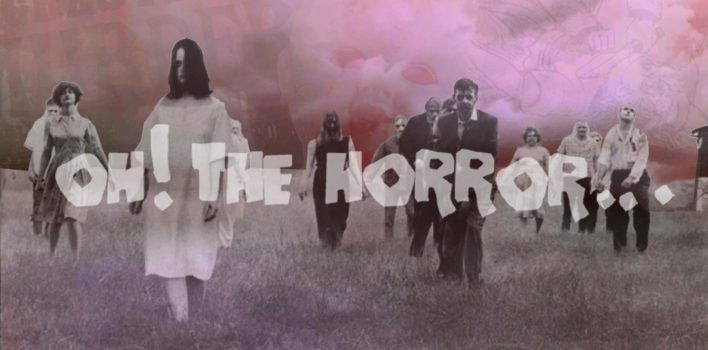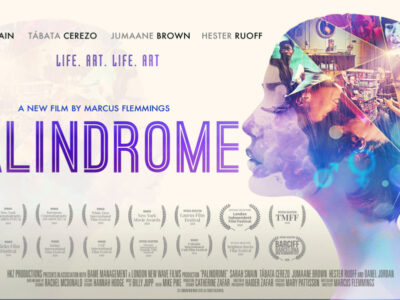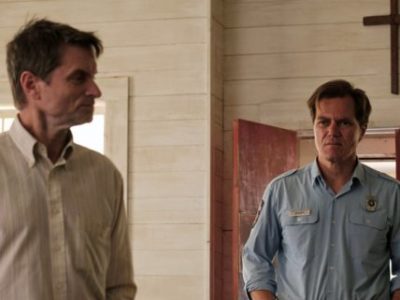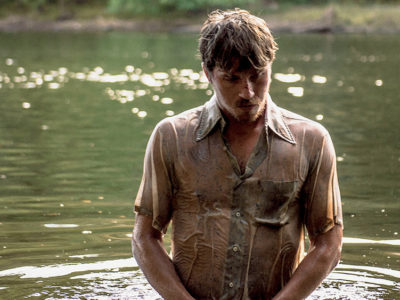Of The 1900s
“And therefore as a stranger give it welcome.
There are more things in heaven and earth, Horatio,
Than are dreamt of in your philosophy.”
–Hamlet, Act I, Scene 5
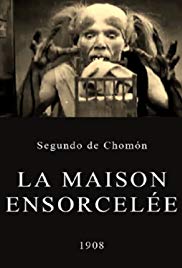 Once the 1900s began, technological advances in cameras and projectors were beginning to proliferate under the marketing and creation of the Lumiére brothers, George Méliès, and new entrepreneurs in the field of filmmaking. In the year 1900 alone, there were new methods being used and new models being introduced to the world: Reulos, Goudeau & Co. came out with the mirographe–a 21 mm amateur format–and Gaumont-Demeny release their own 15 mm amateur format, the Pocket Chrono. The Lumiére brothers introduced their wide format–an impressive 75 mm. At other times, like the 1900 World Fair, the technological drive surpassed the capabilities of the time. Raoul Grimoin-Sanson set up 10 70 mm cameras in an exhibit he called Cinéorama. This spectacle was supposed to simulate a balloon ride over Paris in 360 degrees of vision. The exhibit, however, was shut down due to health concerns from the heat produced from all of the projectors in the space provided.
Once the 1900s began, technological advances in cameras and projectors were beginning to proliferate under the marketing and creation of the Lumiére brothers, George Méliès, and new entrepreneurs in the field of filmmaking. In the year 1900 alone, there were new methods being used and new models being introduced to the world: Reulos, Goudeau & Co. came out with the mirographe–a 21 mm amateur format–and Gaumont-Demeny release their own 15 mm amateur format, the Pocket Chrono. The Lumiére brothers introduced their wide format–an impressive 75 mm. At other times, like the 1900 World Fair, the technological drive surpassed the capabilities of the time. Raoul Grimoin-Sanson set up 10 70 mm cameras in an exhibit he called Cinéorama. This spectacle was supposed to simulate a balloon ride over Paris in 360 degrees of vision. The exhibit, however, was shut down due to health concerns from the heat produced from all of the projectors in the space provided.
Continuity between successive scenes became the central influential element of the 1900s. Stories were starting to be told instead of what often felt like a number of scenes placed together in order to showcase the technology and the “magic” of cinema–this was not necessarily the case within the subgenre of horror however. The first close-up shot arrived in this decade which is often credited to D.W. Griffiths who was known for the emotion he engendered in his films. The Nickelodeon opened in 1905 in Pittsburgh which became the first permanent theater to show films exclusively. Cinema during this decade was starting to become ubiquitous in Europe and North America. As technology is wont to do, once the general concept is created the race begins to make the concept better, more efficient and effortless. The 1900s represented the toddler years of film in which they finally learned how to walk and began to run–still tripping up when they ran faster than they were capable.
George Méliès’ work is all over the 1900s including a full color, nineteen-minute adaptation of the story of Jeanne d’Arc (Joan of Arc to us Americans). However, this reviewer wanted to step away from Méliès and explore some other smaller names working during this decade. Thus the introduction of a fiendishly comical little 6-minute film from French director Segundo de Chomón entitled La maison ensorcelée. The film revolves around three characters, two men and a woman, who arrive at a suspicious little house in the middle of a wood. As they enter and set up for the night there, events take place that amaze and terrify them. A majority of the film follows pretty consistent themes and techniques of horror that started in the 1890s. A single location, weary travelers, and spirits entertaining themselves by making furniture disappear and move around while the travelers look on in horror. There is really nothing specifically different in this film except for a couple of scenes that stand out.
The first scene takes place fairly quickly after the travelers’ arrival to the house. The painting in the frame of the shot disappears and a portal takes its place. Within that portal appears a rather strange, ambiguously-gendered monster. Its hair is in ponytails and it seems to be wearing a sleeveless blouse, yet its creature-like face has more masculine characteristics (even for a monster) that make its appearance effectively odd and creepy. Its long slender fingers are held up before it like a T-rex until it begins barking at the travelers from the picture frame. Seeing this image in the first minute set a significant tone for the film, a tone that wouldn’t necessarily be carried through to the end.
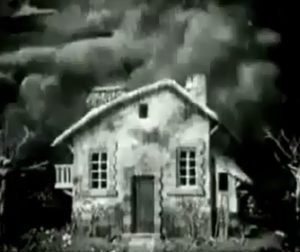 The second scene feels like the centerpiece of the film because of the amount of time spent on this one stop-motion set piece. As the travelers try to calm down enough to have supper, they set up the table and chairs with food found in the house. What transpires next is a ballet in which the food and utensils start to set themselves up on the table, the bread is sliced, the tea is poured and the table is prepared for the travelers. For a film in 1908, this feels like a significant and lengthy vision of ghostly proportions. It is pretty marvelous to attempt to place oneself in the shoes of someone watching this back then and glorying in the innovation of humanity. However, from a modern standpoint, it feels like the scene takes up too much of the film’s time. It doesn’t help that all of the work on that scene basically comes to nothing as the table and the food atop it disappear as they begin to eat. It is a lengthy set up for a joke that does not quite satisfy in comedy or narrative punch.
The second scene feels like the centerpiece of the film because of the amount of time spent on this one stop-motion set piece. As the travelers try to calm down enough to have supper, they set up the table and chairs with food found in the house. What transpires next is a ballet in which the food and utensils start to set themselves up on the table, the bread is sliced, the tea is poured and the table is prepared for the travelers. For a film in 1908, this feels like a significant and lengthy vision of ghostly proportions. It is pretty marvelous to attempt to place oneself in the shoes of someone watching this back then and glorying in the innovation of humanity. However, from a modern standpoint, it feels like the scene takes up too much of the film’s time. It doesn’t help that all of the work on that scene basically comes to nothing as the table and the food atop it disappear as they begin to eat. It is a lengthy set up for a joke that does not quite satisfy in comedy or narrative punch.
Nonetheless, there is enough going on in the film, technically, to make it an enjoyable romp from beginning to end. It gets at a simple concept about modern humanity: the reach of our knowledge of this world is constrained by our bent towards a pervasive materialism. The Enlightenment engendered an unchallenged trust in human sensory information. If we can hear, see, smell, taste or touch something then it has a metaphysical reality. From that, society has built up a system that decides what is acceptable and not acceptable to place faith and belief in. Generally speaking, psychics and ghost hunters, though entertaining, are not often looked on with any seriousness. Devout religious people are given a side-eye, but, as long as they keep their beliefs to themselves, they are tolerated. The general consensus is if humanity can sense it, discover it, measure it then it has been dubbed “real.”
However, films like La maison ensorcelée–and really horror in general, persistently put this theory to the test. The continual existence of psychics, witchcraft, and other non-material practices tell us that something about the materialist perspective is missing an imagination and mystery. This lack of imagination and sense of mystery plays itself out in other ways as well. People become increasingly vitriolic and polarized towards those who are not like them in race, creed, ideology, etc. We cannot imagine ourselves in the shoes of someone we view as different than us because our sensory information reads only the experience that we know and feel. The travelers in the haunted house–or hotel–come up against a reality that they have never considered or, at least, never thought reasonable enough to believe. Their understanding of the world was constrained to the point that they wouldn’t take non-material threats seriously. Something that might have kept them from being devoured in the final scene by the creepy monster that appeared in the first minute of the film. A metaphor for how the things we refuse to believe about the world could literally upend and devour us whole.
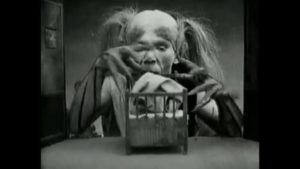 This is not a call to believe in anything and everything that pushes back against the common materialist thought of the age, but a reminder that humanity’s experience of the world is constrained and keeping an open imagination for the existence of things beyond what we can sense is a beneficial exercise. How often do our minds trick us? How often do our experiences conflict with another person’s? How reliable, honestly, are our feelings? Is it possible that our sensory information is guided less by reason and more by the desires of our heart? These are questions that are needed to be asked of ourselves in order to stay honest. It might just help us be able to understand each other with more empathy and compassion if we can attempt to step outside of our existence and enter into another person’s.
This is not a call to believe in anything and everything that pushes back against the common materialist thought of the age, but a reminder that humanity’s experience of the world is constrained and keeping an open imagination for the existence of things beyond what we can sense is a beneficial exercise. How often do our minds trick us? How often do our experiences conflict with another person’s? How reliable, honestly, are our feelings? Is it possible that our sensory information is guided less by reason and more by the desires of our heart? These are questions that are needed to be asked of ourselves in order to stay honest. It might just help us be able to understand each other with more empathy and compassion if we can attempt to step outside of our existence and enter into another person’s.
Also, it might help us avoid creaky old houses that clearly should not be entered. Seriously.


